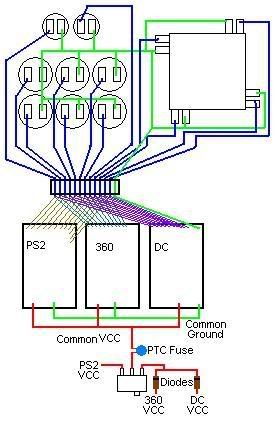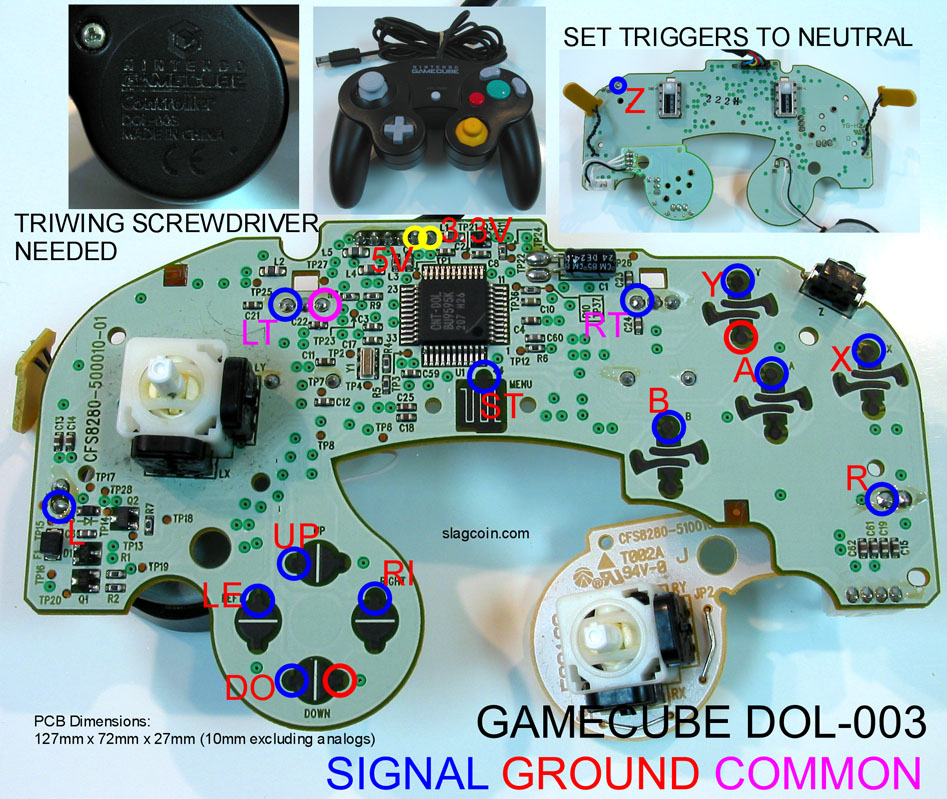Anything in particular you’re looking for? The switch is just a regular SPDT switch; it selects whether the power going to all of the boards is coming from one of the 5v cords (DC, Xbox360) or 3.3v cord (PSX).
My write-up on diodes: Diodes do two things. #1 They allow current to only go through it one way. So, if its wired like shown in that drawing, current can come FROM either one of the two 5v consoles, but no power can go TO either console. This is to protect the consoles so we can draw current from them without accidently force feeding current to them, creating short circuits, blowing fuses, and all manner of nasty things. Draw what we need from one or both, without allowing current from one console to go to the other. #2 Diodes drop the voltage across them. Most cheap diodes will drop about 0.6 volts, so the voltage available from either 5v system will actually be about 4.4v once it gets to the other side of the diode. It’s kind of like a one-way turnstile at a stadium or subway entrace; people have to slow down to go through them, but they sure as hell can’t go through them backwards. That’s also why diodes have markings on one end, because if you put them in backwards, then none of the current we need will be allowed to go through, but the backwards current we want to avoid will be allowed through, so doublecheck your orientations.
The reason he has diodes on the two 5v system and not on the PSX cable is because of that voltage drop. If you drop the 3.3v by 0.6v, you’ve cut the available voltage by 1/3rd, and we quickly get into areas where the possibility of the PSX pad not working is something to worry about. On the 5v systems, we only cut the voltage by about 10%, which is safe to rely on. So, he used a toggle switch.
All of that corner is just to help protect the consoles (and the stick I suppose) against problems if it is plugged into more than one console at a time. If he plugs in the DC and Xbox, the pcb’s will be allows to draw the current they need from either or both systems without worry because the diodes won’t allow current to feed back into the console where it will cause problems. If it’s plugged into the PSX as well, no one cares because the slide switch has the power line disconnected from anything; no power going either direction. If the slide is in the PSX side, then all of the power is comng from the PSX, and there is no way for the pcb’s or PSX to pull power from the 5v systems since they are disconnected at the switch. The two 5v system’s power lines are connected together, but with the diodes there, no current can move either way. Everything’s safe.
Just about any diode can work for this protection; even cheap N4148’s you can find at any Radio Shack. Just look for the cheapest pack of diode’s and you’ll have ones that work. If you don’t mind spending the money on them, you can also try to hunt down diodes with obscenely low voltage drop. The voltage drop (denoted as Vf or ‘forward voltage’ in the datasheets) is how far, umm, the voltage drops across the diode. If you hunt around for one with a very low voltage drop, you can have all three consoles’ power lines connected, using the spendy low voltage drop one on the PSX cable, and whatever diode you like on the 5v systems. Here’s one I found:
http://search.digikey.com/scripts/DkSearch/dksus.dll?Detail?name=VS95SQ015-ND
It’s spendy, but the voltage drop across is less than 0.1 volt. for low current stuff like this.
The PTC fuse is a self resetting fuse, like a circuit breaker that resets itself. If too much current goes through it, it stops the current, hopefully soon enough so your console doesn’t fry. Here’s one that I use for the UPCB:
http://search.digikey.com/scripts/DkSearch/dksus.dll?Detail?name=RXEF040-ND
Zonekeeper: new image looks nice!



